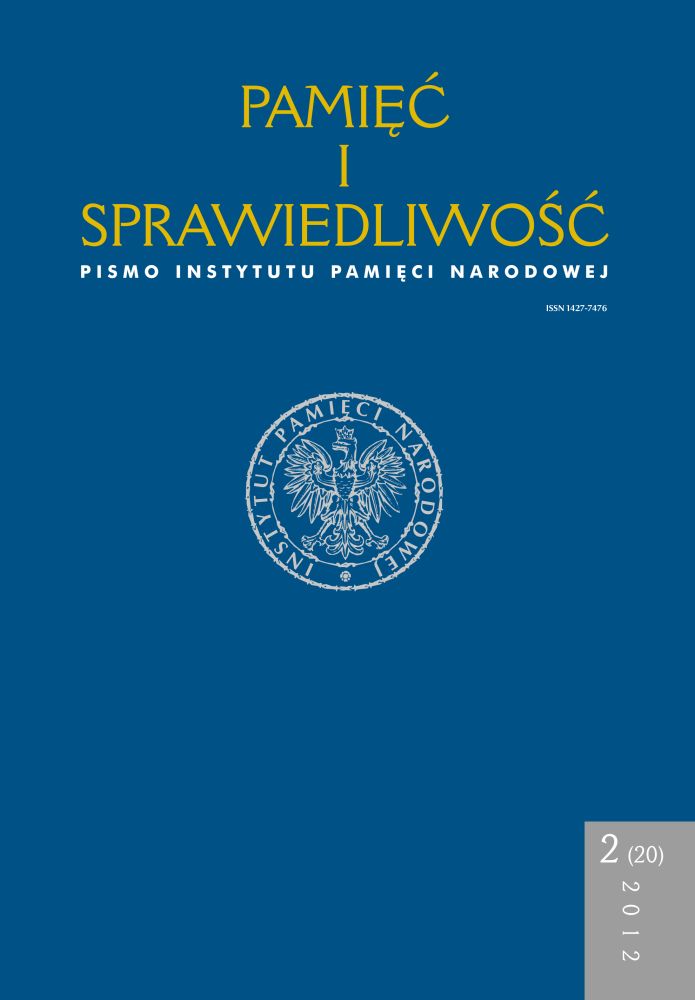Zarys struktur oraz zadania Zwiadu Wojsk Ochrony Pogranicza i Kontroli Ruchu Granicznego w latach 1945–1991
Pamięć i Sprawiedliwość, V. 20 N. 2 (2012), pages: 303-329
Publication date: 2012-12-30
Abstract
Riferimenti bibliografici
J. Ławski, Ochrona granic Polski Ludowej 1945–1948, Warszawa 1974, Z. Jackiewicz, Wojska Ochrony Pogranicza 1945–1991. Krótki informator historyczny, Kętrzyn 1998, H. Dominiczak, Powstanie i rozwój organizacyjny Wojsk Ochrony Pogranicza w latach 1945–1983, Warszawa 1984, (seria „Studia z Dziejów Organów Resortu Spraw Wewnętrznych”, z. 5), J. Prochowicz, Organizacja Wojsk Ochrony Pogranicza wrzesień 1945 r. – grudzień 1945 r., „Problemy Ochrony Granic” 2010, nr 4, s. 7–41; H. Dominiczak, Wojska Ochrony Pogranicza w latach 1945–1985, Warszawa 1986, H. Dominiczak, Zarys historii Wojsk Ochrony Pogranicza 1945–1985, Warszawa 1985, G. Zaremba, Przyczyny reorganizacji WOP w latach 1946–1948, „Biuletyn Centralnego Ośrodka Szkolenia Służby Granicznej im. Marszałka Polski Józefa Piłsudskiego w Koszalinie” 2008, nr 3, s. 95–100; H. Dominiczak, Wojska Ochrony Pogranicza 1945–1991, „Straż Graniczna” maj 1992, s. 17. G. Goryński, Wojska Ochrony Pogranicza w latach 1945–1965. Próba oceny, cz. 1, „Biuletyn Centralnego Ośrodka Szkolenia Służby Granicznej im. Marszałka Polski Józefa Piłsudskiego w Koszalinie” 2011, nr 1, s. 65–69 B. Miśkiewicz, Wojsko Polskie w XX wieku, Poznań 2006, M. Stefaniak, Działalność aparatu represji na zachodnim pograniczu Polski w latach 1945–1950, Szczecin 2008, G. Zaremba, Wpływ przemian politycznych w Polsce po 1956 r. na strukturę organizacyjną WOP oraz uchwalenie dekretu o ochronie granic – 23.03.1956 r., „Biuletyn Centralnego Ośrodka Szkolenia Służby Granicznej im. Marszałka Polski Józefa Piłsudskiego w Koszalinie” 2008, nr 4, s. 77–83. J. Wygoda, Zwiad Wojsk Ochrony Pogranicza jako organ bezpieczeństwa państwa w rozumieniu ustawy lustracyjnej, „Aparat Represji w Polsce Ludowej 1944–1989” 2011, nr 1 (8–9), s. 106 G. Goryński, Rola, miejsce i zadania Wojsk Ochrony Pogranicza w strukturze Ministerstwa Bezpieczeństwa Publicznego (1949–1954) i Ministerstwa Spraw Wewnętrznych (1955–1965), cz. 2, „Problemy Ochrony Granic” 2000, nr 12, s. 54–56. Aparat bezpieczeństwa w Polsce, Kadra kierownicza, t. 2: 1956–1975, red. P. Piotrowski, Warszawa 2006, G. Goryński, Rola, miejsce i zadania Wojsk Ochrony Pogranicza w strukturze Ministerstwa Bezpieczeństwa Publicznego (1949–1954) i Ministerstwa Spraw Wewnętrznych (1955–1965), cz. 1, „Problemy Ochrony Granic” 2000, nr 11, s. 99–102. M. Woźniczko, Służby Ochrony Granic 1918–1990, „Monitor Prawa Celnego” 2001, nr 3, s. 119–123.
 Język Polski
Język Polski
 English
English
 Deutsch
Deutsch
 Français (France)
Français (France)
 Italiano
Italiano
 Русский
Русский


 PDF (Język Polski)
PDF (Język Polski)
